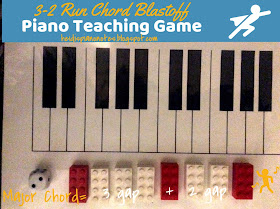Concepts Covered:
- Piano key names
- Major chord building pattern
- Playing and spelling triads
- Broken and blocked chords
Materials needed: Paper Keyboards, die for each player, legos or colored small objects
Object: Be the first to build a chord pattern with legos on the paper keyboard and play and spell it on the piano.
In this fast action game players simultaneously race to roll the "Major chord gaps" (a 3 and then 2) which reinforces the pattern in their mind. It could be played in either a private lesson setting (teacher vs student) or at a group lesson with multiple students playing.
1. Pick a music letter name card to choose which chord you are trying to build.
2. All players place a colored lego on the first note of the chord.

3. Start the race by saying "3-2-1 Blastoff". Players simultaneously race to roll a 3 on their die.

4. When a player rolls a 3 they place 3 white legos on the next 3 higher keys.

5. Next they place a colored lego on the middle note of the triad and then race to roll a 2.
6. After rolling a 2, place white legos on the next 2 keys and add a colored lego to finish off building the chord.

7. Then take note of the chord spelling (keys with colored legos) and "blastoff" toward the piano to spell and play the chord you just built in broken and block style. For C chord you would sing "C-E-G, That's a chord " as you play the broken pattern CEG +3 blocked chords.
8. Repeat if desired choosing a new chord each time until a player wins 3 blastoff rounds.
What makes this game a win?
- Versatile-It could be played in either a private lesson setting (teacher vs student) or at a group lesson with multiple students playing. It's easy to shorten or lengthen the duration by choosing the number of rounds required to win.
- Adaptable- For an easier version, omit the chord spelling requirement for students who haven't learned sharps or flats yet. For a more challenging game, intermediate students could also build other chord styles (minor, diminished, augmented or 7th chords)
- Multi-level- Because of the chance element of the die, an experienced teacher vs. a novice student can play without the teacher having an obvious advantage. The teacher may even be at a slight disadvantage because it's harder to blast off a " mature" body off the floor to race to the piano:).
- Multi-Sensory- This game appeals to multiple learning styles.
- Visual - See the pattern on the keys
- Auditory- Hear both the chord spelling and sound of major chords
- Kinesthetic - Use of block manipulatives and feeling the chord under the fingers as you play it.


No comments:
Post a Comment